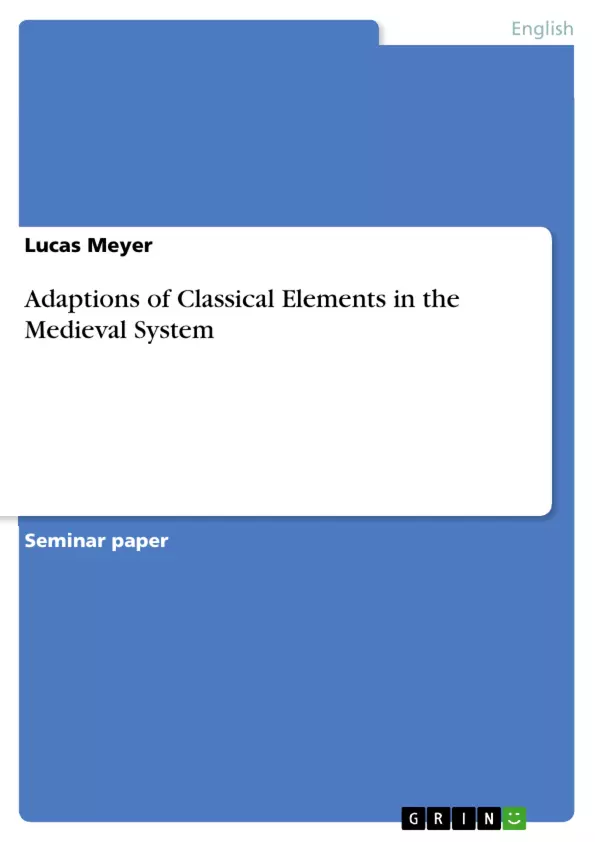References to, and adaptions of classic elements into medieval works and, subsequently society were declared contrary to the Christian doctrine and thus sanctioned and restricted. Considered as “absurd and obscene mythology and practices” (Steel), the prestigious status of the classical world declined. However, this declaration of the Christian institution could not hinder the medieval scholar’s and society’s fascination for the inspiring aspects of antiquity. In fact, the unearthly Christian doctrine lacked explanations about the world enjoyment and factual reason. Therefore, to fill these gaps, the medieval philosopher escaped into paganism. However, in order to utilize the pagan references, the authorities of the academic medieval world were encouraged to seek answers for the question of their legitimization. As a result, an ambiguous and blurry variety of justifications and functions was established that is still in need for clarification. Geoffrey Chaucer’s The Canterbury Tales provides a prototypical categorization of how medieval scholars and writers justified references to the classics and for what purpose they were used. These are distinguishable by perceiving the text in a pagan context, a Christian context, and a universal context.
Inhaltsverzeichnis (Table of Contents)
- References to, and adaptions of classic elements into medieval works and, subsequently society were declared contrary to the Christian doctrine and thus sanctioned and restricted.
- The Canterbury Tales is a conglomerate of medieval literary methodologies and cultural trends that incorporates the extensive utilization of classical elements.
- To construct the framework of this study, the paper first illustrates the theoretical definitions of the categories of justifications and functions. Thereafter, it continues to demonstrate these on the prototypical example of The Canterbury Tales.
- To circumvent the restrictions of the church, three methods of justifying classic references have been developed.
- By implementing these justifications, the medieval works attained legitimized purposes.
- Classic adaptions were, for once, supposed to render an authentic account of the life of the people of antiquity by displaying concrete, manifested human actions.
- In addition, elements of the classics, especially references to established auctors, created academic authenticity and at the same time satisfied the aesthetic mood of the audience of the time.
- The values, virtues and vices depicted in classical narratives were perceived as equal to the Christian standards or even rendered superior.
- The beforehand defined categories of justifications and functions are realizable by perceiving The Canterbury Tales through three different contexts.
- The pagan context of The Canterbury Tales appears as a prolonged instance in the narration of The Knight's Tale.
Zielsetzung und Themenschwerpunkte (Objectives and Key Themes)
This paper examines the justifications and functions of classical elements in medieval works, focusing on how medieval scholars and writers legitimized and incorporated these elements into their own cultural context. It uses Geoffrey Chaucer's The Canterbury Tales as a case study, exploring how the text utilizes classical references within a pagan, Christian, and universal context.
- The legitimization of classical elements in a medieval Christian context
- The various functions of classical references in medieval literature
- The utilization of classical elements in The Canterbury Tales
- The different contexts in which classical references appear in The Canterbury Tales
- The impact of classical elements on medieval society and culture
Zusammenfassung der Kapitel (Chapter Summaries)
The paper begins by outlining the three primary justifications for using classical references in medieval works: the concept of "good pagans," the natural law, and the identification of errors. The paper then delves into how these justifications were applied to various classical elements, including philosophers like Plato and Aristotle, as well as mythological figures and stories.
The paper then examines the three main functions of classical references: history, ornamentation, and moralization. The "history" function involved using classical elements to provide a historical account of ancient life, while the "ornamentation" function highlighted the aesthetic and academic appeal of classical references. The "moralization" function, meanwhile, reinterpreted classical narratives to offer moral lessons relevant to medieval society.
The paper concludes by analyzing how these justifications and functions manifest in The Canterbury Tales, specifically through the Knight's Tale. The paper argues that the Knight's Tale exemplifies a "pagan context" due to its use of classic stories and themes, while also incorporating Christian elements.
Schlüsselwörter (Keywords)
This paper focuses on the intersection of classical elements and medieval society, specifically examining how medieval scholars and writers used references to Greek and Roman antiquity in their works. Key topics include the legitimization of pagan elements in a Christian context, the functions of classical references (history, ornamentation, and moralization), and the application of these principles in Geoffrey Chaucer's The Canterbury Tales.
- Quote paper
- Lucas Meyer (Author), 2020, Adaptions of Classical Elements in the Medieval System, Munich, GRIN Verlag, https://www.grin.com/document/1391398



